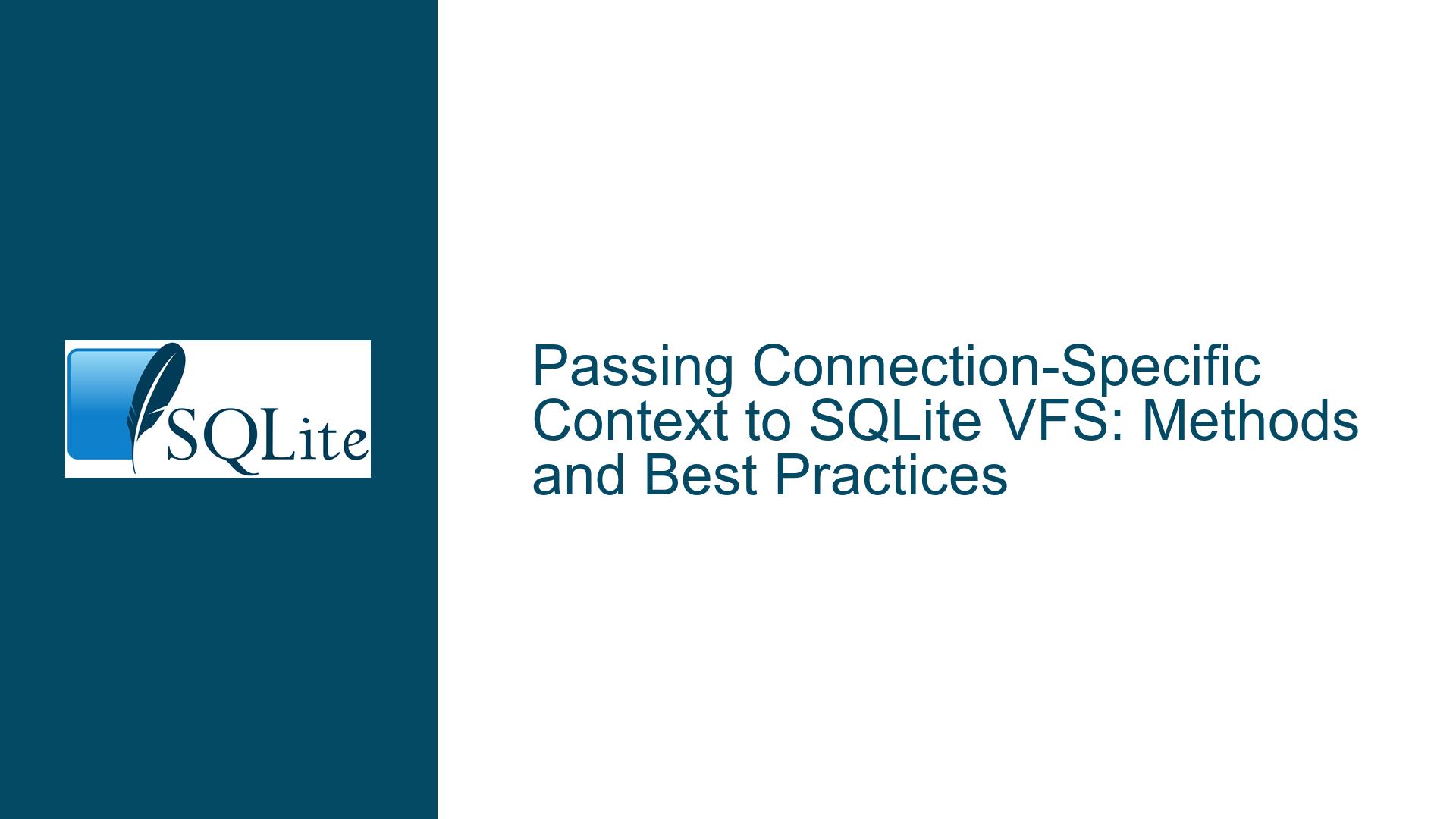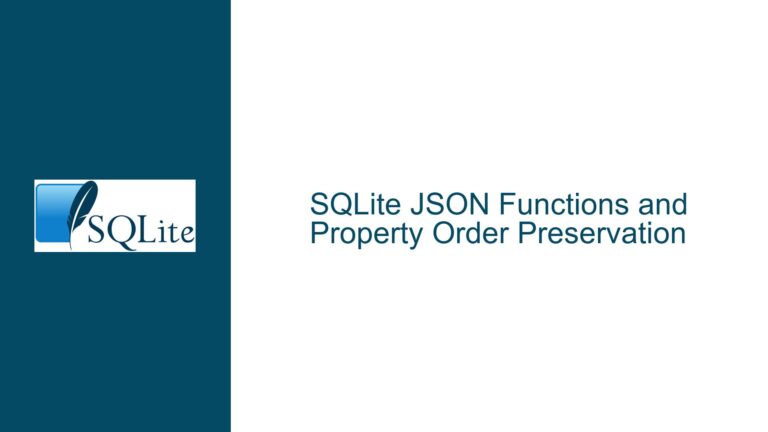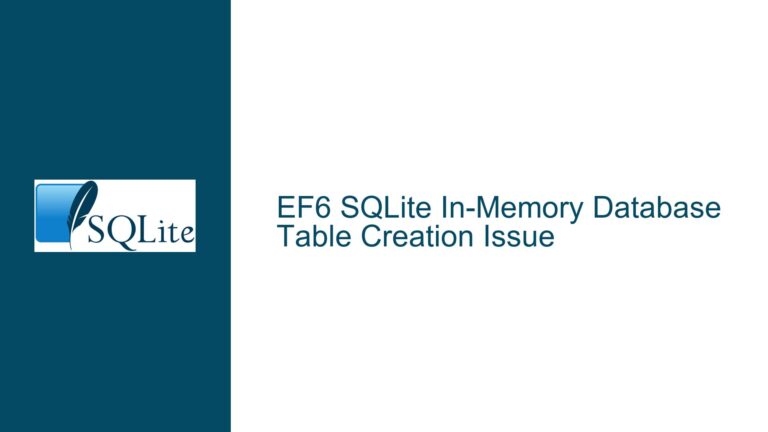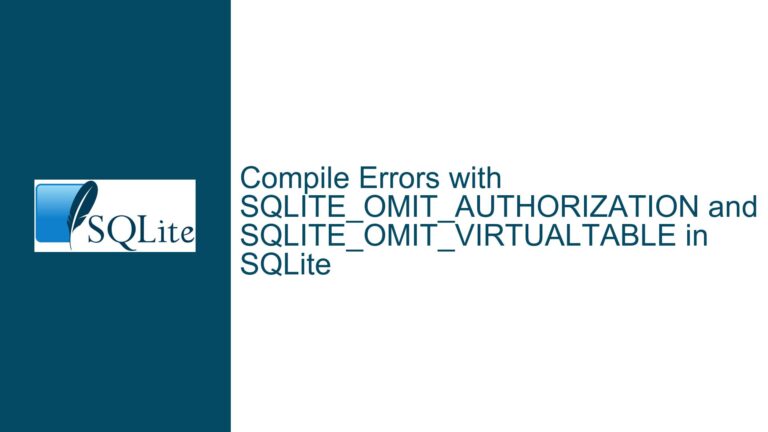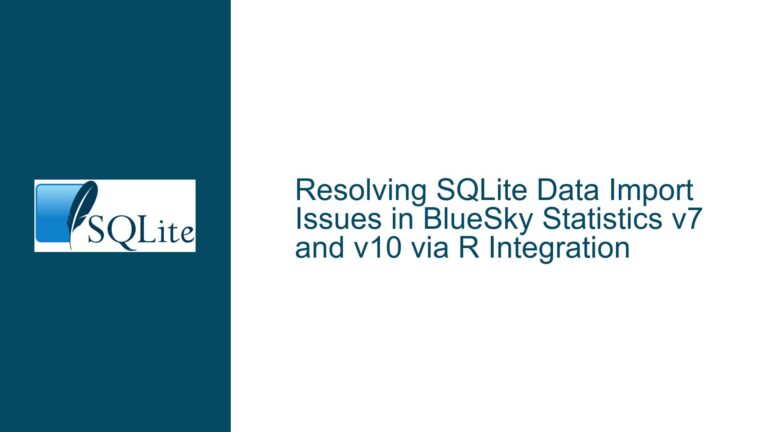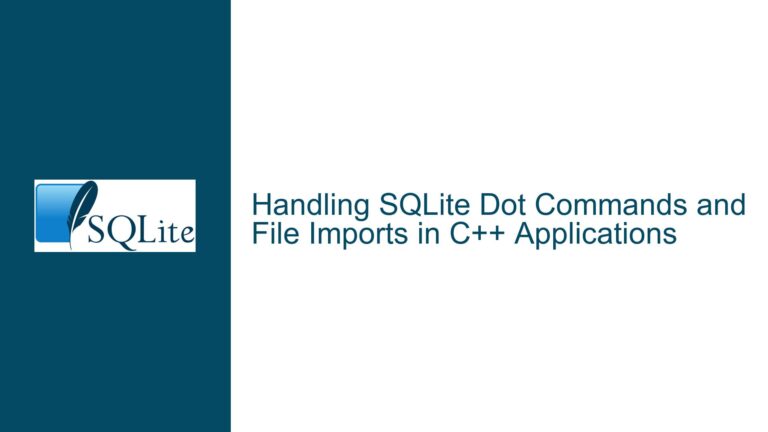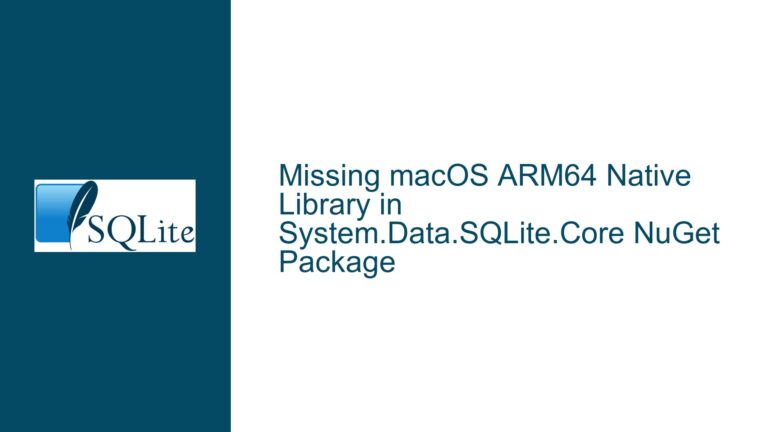Passing Connection-Specific Context to SQLite VFS: Methods and Best Practices
Architectural Constraints & Functional Requirements for Per-Connection VFS Context
Core Challenge: Isolating Connection-Specific Data in a Shared VFS Layer
The SQLite Virtual File System (VFS) layer operates as an abstraction between the database engine and the underlying operating system’s file operations. By design, a single VFS instance can serve multiple database connections. This creates a critical challenge: how to associate unique context data with individual connections when the VFS itself is not inherently connection-aware.
For example, applications may require per-connection metadata such as encryption keys, network endpoint configurations, or audit logs. The SQLite open_v2 function’s vfs parameter specifies which VFS to use but does not provide a mechanism to pass dynamic parameters directly to the VFS during connection initialization. Developers often misinterpret this parameter as a way to configure the VFS per connection, leading to runtime conflicts when global VFS state is modified by concurrent connections.
The absence of a built-in API for connection-specific VFS context forces developers to rely on indirect methods to propagate this data. Three primary strategies emerge from SQLite’s extensibility model: URI parameters, the xFileControl interface, and custom pragmas via SQLITE_FCNTL_PRAGMA. Each approach has distinct trade-offs in complexity, performance, and integration depth.
Root Causes of VFS Context Propagation Failures
1. Misuse of Global Variables for Connection-Specific State
A common anti-pattern involves storing context data in global variables or static memory regions accessible to the VFS. This violates thread safety and connection isolation principles, especially in multi-threaded environments where connections operate concurrently. For instance, if Connection A sets a global encryption key and Connection B overwrites it before Connection A completes its write operation, data corruption or leakage becomes inevitable.
2. Overlooking URI Parameter Extraction in VFS Initialization
The sqlite3_uri_parameter API allows VFS implementations to parse key-value pairs from database filenames formatted as URIs. However, developers frequently fail to implement URI parsing in the VFS’s xOpen method, which is the only point where URI parameters are directly accessible during connection establishment. Without explicit handling, parameters embedded in the filename (e.g., file:data.db?key=value) are silently ignored.
3. Incomplete Integration of the xFileControl Interface
The xFileControl method in the sqlite3_io_methods structure enables custom command/response interactions between the SQLite core and the VFS. If this method is unimplemented or partially implemented, the VFS cannot respond to sqlite3_file_control invocations from the application layer. This gap prevents the runtime injection of context data after the connection is opened.
4. Undefined SQLITE_FCNTL_PRAGMA Handling for Custom Pragmas
Pragmas are SQL commands that modify database runtime parameters. The SQLITE_FCNTL_PRAGMA file control operation allows the VFS to intercept pragma statements and return dynamically generated results. Applications that omit this handler lose the ability to configure VFS context through SQL, forcing context management into external application code.
Implementation Strategies for Robust Per-Connection Context Handling
Strategy 1: URI Parameters for Initial Context Injection
Step 1: Construct a URI Filename with Parameters
When opening a database connection, append parameters to the filename URI:
sqlite3_open_v2("file:data.db?cache_size=2048&mode=ro", &db, SQLITE_OPEN_READONLY, "custom_vfs");
Step 2: Extract Parameters in the VFS xOpen Method
In your VFS implementation, override the xOpen method to parse parameters using sqlite3_uri_parameter:
int xOpen(sqlite3_vfs* vfs, const char* zName, sqlite3_file* file, int flags, int* pOutFlags) {
const char* cache_size = sqlite3_uri_parameter(zName, "cache_size");
const char* mode = sqlite3_uri_parameter(zName, "mode");
// Store parameters in file->pMethods->pAppData or a custom struct
return SQLITE_OK;
}
Step 3: Validate and Sanitize Parameter Values
URI parameters are strings; convert them to application-specific types (integers, enums) with error handling:
long cache_size_val = 0;
if (cache_size != NULL) {
char* endptr;
cache_size_val = strtol(cache_size, &endptr, 10);
if (*endptr != '\0') {
// Handle invalid integer format
return SQLITE_ERROR;
}
}
Limitations:
- Parameters are static; cannot be modified after connection opening.
- Exposed in connection strings and application logs (security risk for sensitive data).
Strategy 2: Dynamic Context Updates via xFileControl
Step 1: Implement the xFileControl Method
Extend your VFS’s sqlite3_io_methods structure to include an xFileControl handler:
int xFileControl(sqlite3_file* file, int op, void* arg) {
CustomFile* pFile = (CustomFile*)file;
switch (op) {
case MY_CUSTOM_FCNTL_SET_CONTEXT: {
pFile->pContext = arg; // Store context pointer
return SQLITE_OK;
}
default:
return SQLITE_NOTFOUND;
}
}
Step 2: Invoke sqlite3_file_control from Application Code
After opening the database, send context data to the VFS:
sqlite3* db;
sqlite3_open_v2("data.db", &db, SQLITE_OPEN_READWRITE, "custom_vfs");
MyContext ctx = { .cache_size = 2048, .mode = READ_ONLY };
sqlite3_file_control(db, "main", MY_CUSTOM_FCNTL_SET_CONTEXT, &ctx);
Step 3: Synchronize Access to Context Data
Use mutexes or atomic operations if the context is modified after initialization:
pthread_mutex_lock(&pFile->mutex);
pFile->pContext->cache_size = new_size;
pthread_mutex_unlock(&pFile->mutex);
Advantages:
- Enables runtime context updates.
- Bypasses URI parameter length restrictions.
Strategy 3: SQL-Integrated Configuration via Custom Pragmas
Step 1: Handle SQLITE_FCNTL_PRAGMA in xFileControl
Intercept pragma statements by processing SQLITE_FCNTL_PRAGMA in your xFileControl implementation:
case SQLITE_FCNTL_PRAGMA: {
const char** pragma_args = (const char**)arg;
if (strcmp(pragma_args[1], "custom_cache_size") == 0) {
int size = atoi(pragma_args[2]);
pFile->pContext->cache_size = size;
pragma_args[0] = "OK"; // Return result to SQLite
return SQLITE_OK;
}
return SQLITE_NOTFOUND;
}
Step 2: Execute PRAGMA Statements via SQL
Configure the VFS context directly from SQL:
PRAGMA custom_cache_size = 2048;
Step 3: Surface Context Data via SQL Functions
Expose runtime context through custom SQL functions for debugging:
sqlite3_create_function(db, "get_cache_size", 0, SQLITE_UTF8, NULL, get_cache_size_func, NULL, NULL);
Security Considerations:
- Validate input values rigorously to prevent SQL injection.
- Restrict pragma usage to privileged users if applicable.
Comparative Analysis & Decision Framework
| Criterion | URI Parameters | xFileControl | Custom Pragmas |
|---|---|---|---|
| Initialization Time | At connection open | Anytime post-open | Anytime via SQL |
| Data Sensitivity | Unsuitable for secrets | Secure with proper access control | Secure with proper access control |
| SQL Integration | None | None | Full |
| Runtime Overhead | Low | Medium | Medium-High |
| Implementation Complexity | Low | Medium | High |
Recommendations:
- Use URI parameters for simple, static configuration (e.g., read-only mode).
- Prefer xFileControl for sensitive or dynamic data requiring runtime updates.
- Adopt custom pragmas when SQL-driven configuration is essential (e.g., user-defined settings).
By systematically applying these strategies, developers can overcome SQLite’s VFS layer limitations and achieve robust per-connection context management.
